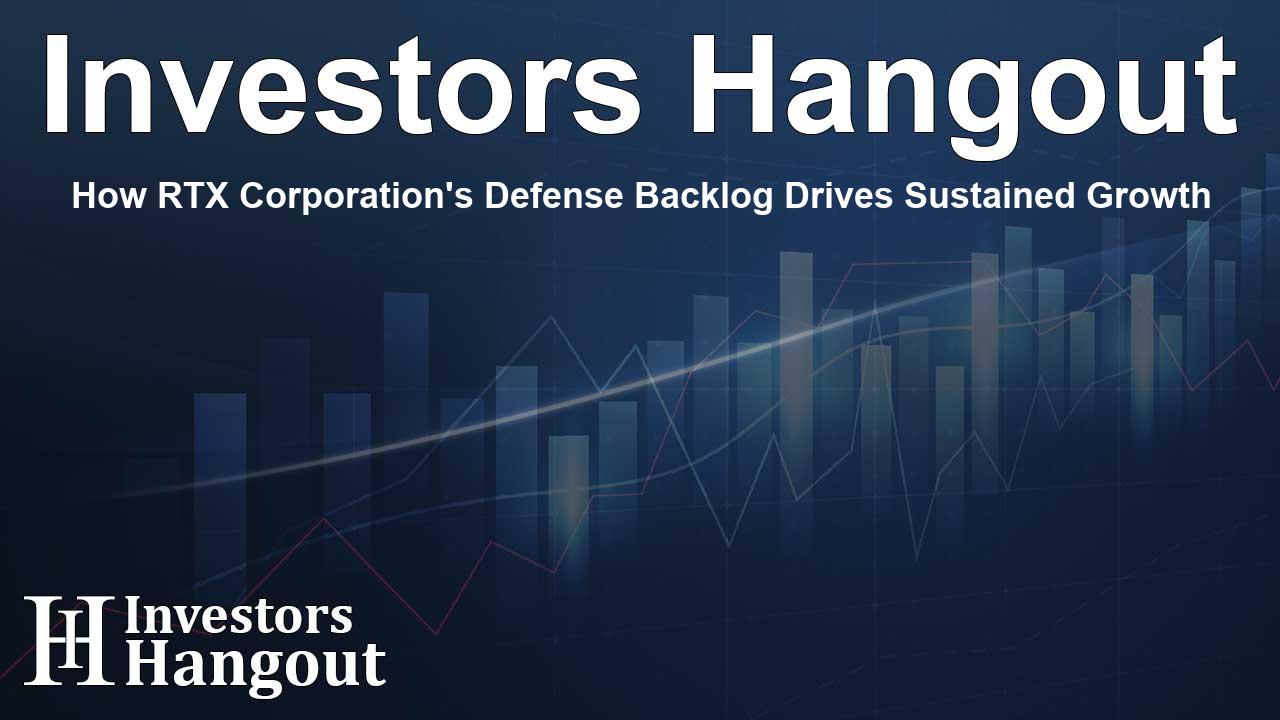How RTX Corporation's Defense Backlog Drives Sustained Growth

How RTX Corporation's Defense Backlog Drives Sustained Growth
The global market is shaped significantly by two prominent forces: increasing geopolitical instability and a steadfast demand for commercial air travel. In such a unique landscape, few companies stand ready to navigate both realms effectively. RTX Corporation (NYSE: RTX) is particularly well-equipped to handle these trends.
This aerospace and defense powerhouse operates on a dual focus, catering to governments that are enhancing their national security while also supporting commercial airlines that are expanding their fleets in response to rising travel demand.
At the heart of RTX's appeal as an investment lies its Raytheon segment. In these times of escalating global defense expenditures, this division delivers a reliable and growing stream of revenue that is relatively insulated from fluctuations in the broader economy. A vital indicator of this stability is the segment's impressive defense backlog, which reached a staggering $93 billion, reflecting robust demand for their high-demand products.
This backlog translates into concrete future sales, offering a multi-year advantage for RTX's stock performance. Noteworthy programs contributing to this growth trajectory include:
Key Programs Driving Growth at RTX
- Air and Missile Defense: Nations are prioritizing the modernization of their air and missile defense capabilities, with the much-acclaimed Patriot system being a focal point. A recent contract worth $2.4 billion to supply these systems to Germany underscores the persistent demand from critical NATO allies.
- Advanced Munitions: The demand for precision weapons remains exceptionally high. RTX's Raytheon division is a leader in this sector, known for the AMRAAM air-to-air missiles and the Evolved SeaSparrow Missile (ESSM) program, which recently secured a contract modification worth $299.7 million.
- Next-Generation Systems: RTX is ramping up production of its Lower Tier Air and Missile Defense Sensor (LTAMDS) as part of a critical transition to more advanced systems. A recent $1.9 billion contract for the U.S. and Poland highlights their focus on responding to evolving threats.
For investors, this expansive backlog acts as a significant de-risking mechanism, providing clear visibility into future earnings and cash flow. This strategy secures RTX from the uncertainties of short-term market fluctuations, allowing management to confidently pursue its long-term capital objectives.
A Growth Engine With a Clear Flight Path
While the Raytheon segment anchors the stability of RTX, its commercial aerospace branches, such as Pratt & Whitney and Collins Aerospace, deliver substantial growth potential. The recovery in global air travel has resulted in a notable surge in aircraft maintenance, repair, and overhaul (MRO) activities, evidenced by a remarkable 21% year-over-year increase in commercial aftermarket sales during the initial quarter of 2025.
A significant concern among investors has been the Pratt & Whitney Geared Turbofan (GTF) engine issue which necessitated expedited inspections. However, RTX has devised a comprehensive strategy to manage this situation successfully, and the market response indicates a solid understanding of the financial implications.
RTX has made tangible advancements, enhancing its MRO output by approximately 30% in 2024. This thorough inspection initiative supports a dependable and high-margin services stream expected to extend for many years.
Further confidence in the long-term viability of the GTF platform persists. The engine's exceptional fuel efficiency continues to attract interest, as seen in over 950 new orders and commitments secured in 2024. With a commercial backlog totaling $125 billion, this segment is poised for recovery, driving noteworthy future growth.
The Price of Quality
Given its strong market performance, RTX now exhibits a valuation that reflects its optimistic future outlook. Currently trading at a price-to-earnings ratio (P/E) of about 24, the stock is regarded as a premium investment compared to its recent historical averages. For many investors, this premium represents the value of quality and stability in today's marketplace.
Operationally, it is crucial to monitor the effective execution of the multi-year GTF fleet management plan. RTX's leadership expresses gratifying confidence; however, the scale of this undertaking necessitates relentless focus to ensure success.
On the external front, RTX, being a global leader, is subject to broader macroeconomic risks, including potential international tariffs, a standard consideration for multinational industrial firms.
A Unique Blend of Stability and Shareholder Value
RTX’s investment appeal is grounded in a well-structured balance. The Raytheon segment guarantees stability through sustained demand for national security, while the commercial aerospace sectors promise growth stemming from the enduring trend of global travel expansion. This equilibrium empowers the company to navigate diverse economic scenarios effectively.
This operational prowess translates seamlessly into financial might, allowing RTX to deliver substantial value back to its stakeholders. Recently, the company announced a 7.9% increase in its dividend, signaling management's strong confidence in forthcoming cash flows. This move is underscored by an impressive 88-year history of dividend payments, solidifying its status as a reliable blue-chip stock.
For investors looking for a solid foundation in the vital aerospace and defense industry, RTX's diverse business model and proven dedication to shareholder returns present a compelling opportunity for long-term value generation.
Frequently Asked Questions
What is RTX Corporation known for?
RTX Corporation is recognized as a major player in the aerospace and defense sectors, catering to government and commercial aviation markets.
How significant is RTX's defense backlog?
The defense backlog at RTX stands at an impressive $93 billion, providing significant visibility into future sales and earnings.
What are the key growth drivers for RTX?
RTX's growth is driven by its military contracts, advanced munitions, and a recovering commercial aerospace sector, particularly aircraft maintenance and repairs.
How does RTX manage economic fluctuations?
RTX operates with a dual focus on defense and commercial aviation, which allows it to stabilize its revenue streams amidst economic fluctuations.
What recent developments have occurred in RTX's commercial segment?
RTX has improved its maintenance repair operations significantly, and the GTF engine remains a pivotal component in attracting new orders, securing over 950 commitments in 2024.
About The Author
Contact Kelly Martin privately here. Or send an email with ATTN: Kelly Martin as the subject to contact@investorshangout.com.
About Investors Hangout
Investors Hangout is a leading online stock forum for financial discussion and learning, offering a wide range of free tools and resources. It draws in traders of all levels, who exchange market knowledge, investigate trading tactics, and keep an eye on industry developments in real time. Featuring financial articles, stock message boards, quotes, charts, company profiles, and live news updates. Through cooperative learning and a wealth of informational resources, it helps users from novices creating their first portfolios to experts honing their techniques. Join Investors Hangout today: https://investorshangout.com/
The content of this article is based on factual, publicly available information and does not represent legal, financial, or investment advice. Investors Hangout does not offer financial advice, and the author is not a licensed financial advisor. Consult a qualified advisor before making any financial or investment decisions based on this article. This article should not be considered advice to purchase, sell, or hold any securities or other investments. If any of the material provided here is inaccurate, please contact us for corrections.
